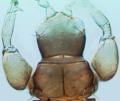Nesothrips propinquus
Recognition data
Distinguishing features
Female usually wingless, sometimes fully winged. Abdomen dark brown, head and thorax commonly yellowish, legs usually yellow; antennal segments I–IV usually yellow, distal segments brown; major setae brown, fore wing deeply shaded. Head wider than long, narrowed to base, eyes prolonged on ventral surface; one pair of ocellar setae arising between posterior ocelli, postocular setae finely pointed, about as long as eye; maxillary stylets broad, not retracted to postocular setae, wide apart and V-shaped. Antennae 8-segmented; segment III with 2 slender sensoria, IV with 4 sensoria; segment VIII slender and narrowed to base. Pronotum with five pairs of bluntly pointed major setae; epimeral sutures complete; basantra weakly sclerotized, ferna and mesopresternum transverse. Fore tarsi with no tooth. Metanotum with no sculpture medially. Fore wing parallel sided, broad, with no duplicated cilia. Pelta variable, broad with prominent and often separated lateral wings; tergites with one pair of sigmoid wing-retaining setae, weak in apterae; tergite IX setae pointed, shorter than tube; tube shorter than head.
Male usually wingless, very rarely winged. Large males with fore tarsal tooth large, and fore femora swollen.
Related and similar species
The genus Nesothrips includes 28 species, mainly from Australia, New Zealand and the Pacific region. The genus is closely related to Carientothrips, a genus which also has many species in the same part of the world. A key to 14 species in this genus was provided by (Mound 1974b), but N. propinquus is variable in structure, within and between sexes (Mound, 1974a).
Taxonomic data
Current valid name
Nesothrips propinquus (Bagnall)
Original name and synonyms
- Oedemothrips propinquus Bagnall, 1916: 408
- Cryptothrips dimidiatus Hood, 1918: 145
- Bagnalliella cestosa Karny, 1920: 41
- Oedemothrips propinquus var. breviceps Bagnall, 1924: 634
- Oedemothrips propinquus f. obscuricornis Bagnall, 1924: 634
- Neosmerinthothrips oleriae Moulton. 1949: 492
- Bolothrips similis Hartwig, 1948: 103
Family placement
Phlaeothripidae, Idolothripinae
Biological data
Life history
Breeding particularly at the base of tussocks of grasses, but also found on dead twigs.
Host plants
Feeding by imbibing fungal spores.
Tospoviruses vectored
None
Crop damage
None
Distribution data
Area of origin
Possibly New Zealand
Distribution
Widespread from New Zealand and southern Australia along the old sailing-ship route to Europe, including South Africa and islands in the Atlantic. Found once in California, during June 2006 in Marin County, near San Francisco, from amongst dead grasses.




